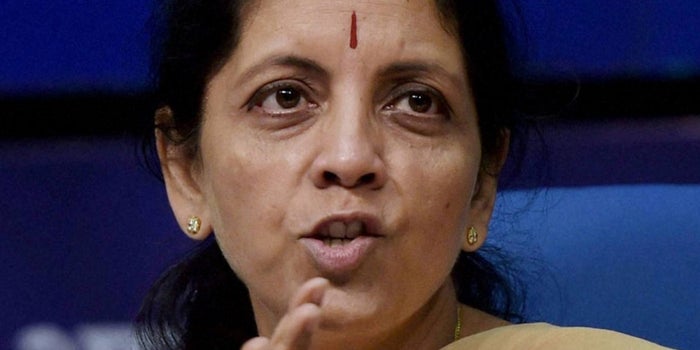India’s finance minister Nirmala Sitharaman on Saturday presented the first budget of the new decade, with a broad focus around three themes: aspirational India, economic development and a caring society. “This is the budget to boost growth and enhance purchase power,” she said, adding that the country will be a caring economy and attend to all citizens, including the weak and vulnerable ones.
At a time when a falling economy has left everyone worried, Sitharaman said the central government’s debt has been reduced to 48.7 per cent of gross domestic product in 2019, from 52.2 per cent of GDP in 2014.
She said the government estimates a nominal GDP growth of 10 per cent in the next fiscal year and a fiscal deficit of 3.5 per cent.
Through the day, the Sensex fell about a thousand points, despite starting more than a hundred points higher when the presentation started.
Agriculture
India, where for about 58 per cent of the population, agriculture remains the primary source of livelihood, has over the years seen several government schemes and incentives to boost the sector.
In her budget as well, Sitharaman had a keen focus on the sector and said they are committed to doubling farmer income by 2022.
She presented a 16-point plan to improve the state of farming and agriculture, which included expansion of the KUSUM scheme that reduces dependence on traditional sources of energy. There was a focus on solar energy, with the finance minister stating that the government can help farmers with barren land to set up solar pumps. The government would also build a national cold supply chain for perishables to help farmers.
India’s milk processing capacity would be doubled to 108 million metric tonnes from 53 million metric tonnes by 2025, she said, while fish production would be raised to 200 lakh tonnes by 2022-23. There would be a framework for development, management and conservation of fishery resources.
“The government’s commitment to support the…marine fishery resources will be a big boost to marine exports originating from India,” said Pushkar Mukewar, co-CEO at Drip Capital.
For the sector comprising agriculture, allied activities, irrigation and rural development, the government has made an allocation of INR 2.83 lakh crore for 2020-21. Agri credit target for the fiscal year has been proposed at INR 15 lakh crore.
Healthcare
Sitharaman allocated INR 69,000 crore to the healthcare sector, an increase of more than INR 6000 crore over last year. She said the government would open hospitals in tier-II and tier-III cities covered under aspirational districts scheme and added that it would use proceeds from taxing medical devices to build new infrastructure to help the sector.
Dr. GSK Velu, chairman and managing director at Trivitron Healthcare called the budget “visionary” and said it was in accordance with the government’s policy of improving and expanding healthcare services reach to everyone. “Imposing health cess on the import of medical devices will help domestic manufacturing companies,” he said.
She proposed INR 35,600 crore for nutrition-related schemes and said over 6 lakh anganwadi workers had been equipped with smartphones to upload the nutrition details of over 10 crore households.
The government remained committed to its open defecation free country initiatives, she said. INR 3.6 lakh crore was allocated to sanitation and pipeline projects while INR 12,300 crore for the Swachh Bharat initiative.
“While the broader goal of leveraging cut-throat technologies in healthcare is the right direction, the key question now is whether the budgets get used and allocated for the most meaningful applications and use-cases which can deliver the desired outcomes,” said Akansh Khurana, co-founder and CEO at clinical intelligence firm THB.
Education
For a country considered among the youngest in the world, education remains a vital cog in the wheel. In her budget, Sitharaman allocated INR 99,300 crore for the sector and INR 3,000 crore for skill development. A significant announcement was that the government would allow foreign direct investment (FDI) in education.
“While the focus on scaling up youth’s skill set is necessary, the budget had a glaring lack of initiatives for primary and secondary education which is the foundation of one’s life and career,” said Zishaan Hayath, co-founder and CEO at edtech firm Toppr.
Sitharaman said that the government would announce a new education policy soon. Apart from that, she proposed that the government start a programme for young engineers wherein they are given internship opportunities by urban local bodies.
The budget also included a proposal for a degree level full-fledged online education programme by top-100 institutions in the National Institutional Ranking Framework. Hayath called this move a welcome development while Gradeup’s co-founder Shobhit Bhatnagar said online education was the way forward given its affordability and accessibility.
“However, we need more clear and concrete steps that could upgrade our education system significantly,” added Hayath.
Infrastructure
Sitharaman said 5 new Smart cities would be set up via the public-private partnership model. There would be faster development of highways with the Delhi-Mumbai expressway and two other projects aimed to be completed by 2023. A total of INR 100 lakh crore would be spent on infrastructure over the next five years, she said.
A national logistics policy would be released soon, which would create one combined online logistics market. “Creation of single-window clearances and rolling out more favourable policies is another step as logistics is important and will act as a catalyst in driving economic growth,” said T.A. Krishnan, co-founder and CEO at Ecom Express.
Kushal Nahata, co-founder and CEO at FarEye, felt the government’s focus on promoting tech such as artificial intelligence and Internet of Things was critical for the supply chain and logistics industry. . “It’s important for enterprises to leverage these technologies to improve operational efficiencies and keep margins wider,” he said.
Under a project preparation facility, the finance minister said young engineers and management graduates would be hired for infra projects.
She allocated INR 1.7 lakh crore to transportation.
Energy
The budget allocated INR 22,000 crore to power and renewable energy as the finance minister advised utilities to shut thermal plants if they did not meet emission regulations.
Sitharaman also said the Centre has proposed conventional meters to be replaced with smart prepaid meters and give option to consumers to choose electricity suppliers. State governments have 3 years to do the meter replacement, she said.
“The announcement made by FM to replace energy meters with pre-paid smart meters will further help in complete digitization of the whole system and will help in bring about more financially healthier utilities,” said Gautam Seth, joint-managing director at HPL & Electric Power.
She said the country’s natural gas pipeline grid will be expanded to 27,000 km from over 16,000 km.
Separately, she allocated INR 4,400 crore for the purpose of environment and climate change, while stating that India was committed towards the Paris Climate Agreement.
Start-Ups
Having already shown its willingness to support the growing start-up ecosystem in India, the finance minister once again made it clear that it remained a key focus area for them.
“Entrepreneurship has always been the strength of India,” she said. In her budget, she proposed a seed fund to support early-stage start-ups and an investment and advisory cell for budding entrepreneurs. Separately, she proposed an online portal to facilitate faster clearances for businesses at the state and central level.
To help protect intellectual property, which has become a big talking point considering the innovation coming out of start-ups in the last few years, she announced that the government would have a digital platform for the same.
Sitharaman said data was the new oil and proposed setting up data farms to help incorporate data at each part of the value chain and allocated INR 6,000 crore under the Bharat Net programme, which is meant to focus on improving internet connectivity across the country.
Stating that the online marketplace has a lot of opportunities for small and medium enterprises, Sitharaman allocated INR 27,300 crore for development of industry and commerce.
Exports
To boost exports, the finance minister proposed a new scheme Niryat Rin Vikas Yojana or NIRVIK.
It will provide for high insurance cover, with premium reduced for small exporters and procedures simplified for claim settlements. She also proposed to subsidise the premium that has to be paid by exporters of certain sectors. Under the scheme, the insurance guaranteed could cover up to 90 per cent of the principal and interest, up from about 60 per cent currently.
In December, India’s exports fell by 1.8 per cent to $27.36 billion from a year earlier.
Culture and Tourism
Sitharaman allocated INR 2,500 crore for tourism promotion and INR 3,150 crore to the ministry of culture.
An Indian Institute of Heritage and Conservation was proposed by her while she said that five archaeological sites – Rakhigarhi (Haryana), Hastinapur (Uttar Pradesh), Shivsagar (Assam), Dholavira (Gujarat) and Adichanallur (Tamil Nadu) – would be developed as iconic sites with on-site museums.
“It is heartening to see a budget that focuses on improving standards of living as well as economic development,” said Rohit Kapoor, CEO at OYO for India and South Asia, and added that the steps taken were bright indicators of the renewed focus of the government on the industry.
There would also be support from the government for setting up a tribal museum in Rachi, Jharkhand and maritime museum would be set up at Lothal, the Harappan age maritime site near Ahmedabad, Gujarat.
Separately, the finance minister said that 100 more airports would be developed by 2024 under the Udaan scheme and air fleet number was expected to double to 1,200 during the same period. In rail, she said more Tejas type trains would be introduced to connect iconic tourist destinations.
“With this budget, we are confident to share that the Indian tourism sector is set to witness multi-fold growth,” said Mohit Poddar, CEO at Shoes on Loose, an experiential travel company.
[Budget 2020] 3-themed Budget Seeks To Address High Unemployment, Low Demand and Falling Economy was originally published on entrepreneur.




